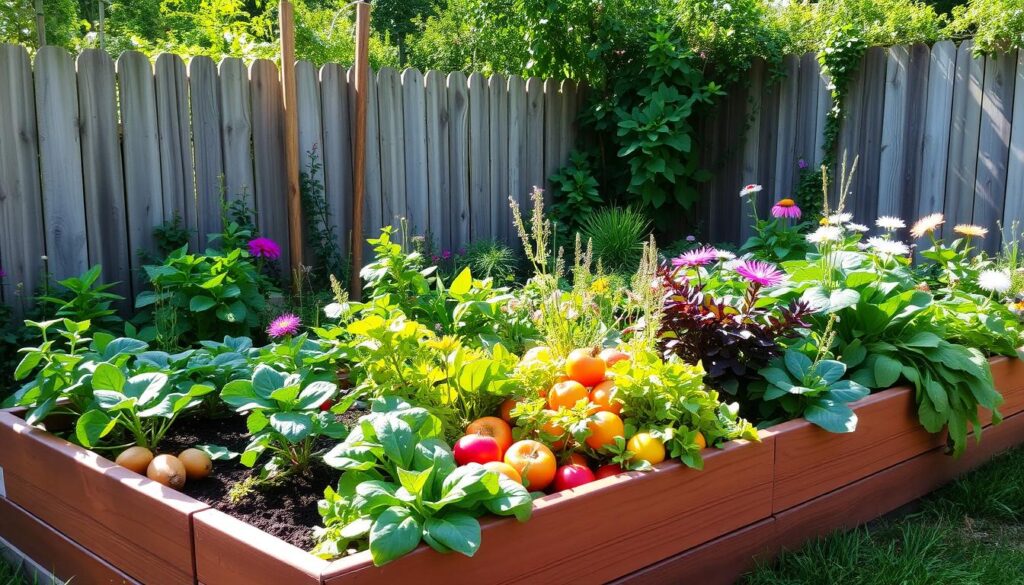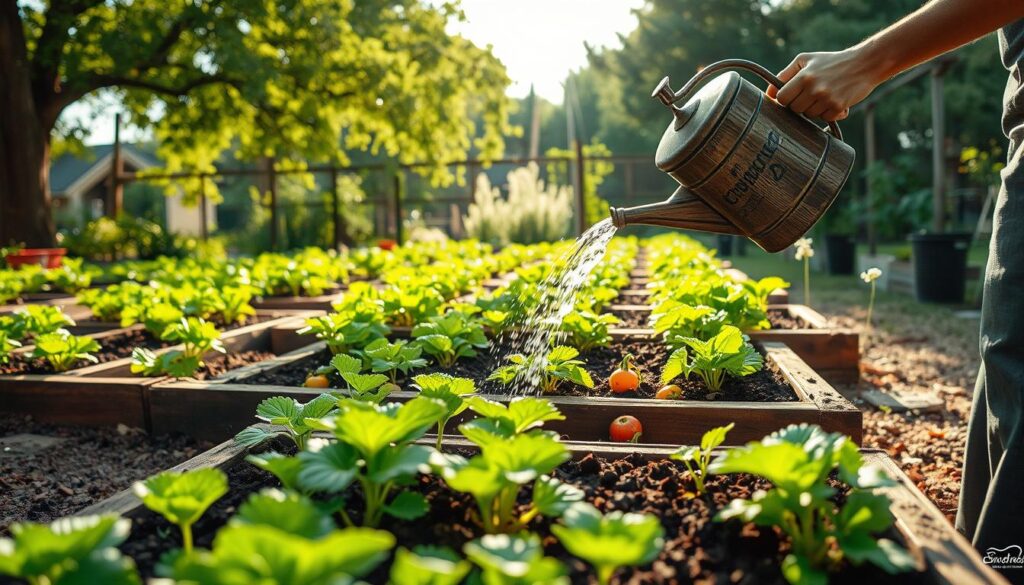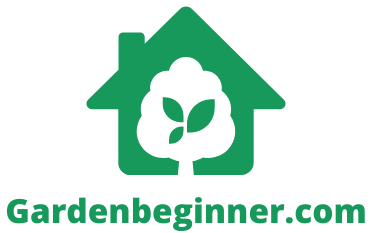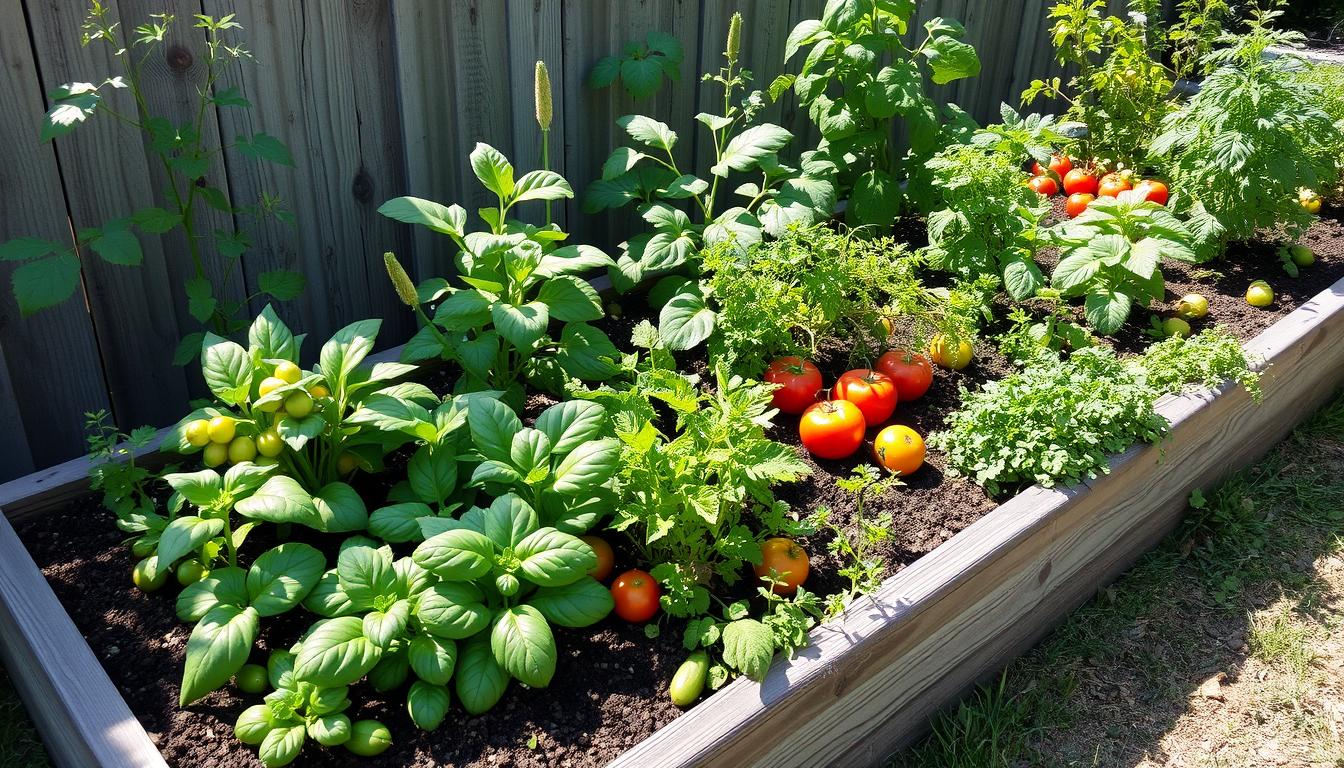Are you ready to elevate your gardening game? Raised bed gardening is a game-changer. It can transform how you grow your favorite herbs, fruits, and veggies. In this guide, I’ll show you how to start and keep a raised bed garden thriving. We’ll cover everything from picking the best spot to building and soil preparation.
Key Takeaways
- Raised bed gardening offers improved soil quality, better drainage, and easier maintenance compared to traditional in-ground gardening.
- Choosing the right location with ample sunlight is crucial for vegetable growth.
- Building a customized raised bed with the appropriate size and height can maximize your gardening space and productivity.
- Preparing the soil by amending it with nutrient-rich materials ensures optimal plant growth.
- Selecting the right mix of companion plants can help deter pests and enhance the overall health of your raised bed garden.
Why Start a Raised Bed Vegetable Garden?
Gardening fans are turning to raised bed vegetable gardens for their benefits. These elevated spaces offer advantages over traditional gardens. They are a top pick for home gardeners. Let’s look at why starting a raised bed garden is a good idea.
Benefits of Raised Bed Gardening
One big plus is improved soil quality. Raised beds ensure plants get the right soil. This leads to healthier plants and more food.
Another big plus is better drainage. Raised beds help water drain, avoiding soggy soil. This is great for areas with bad drainage.
- Easier access and reduced weed growth
- Longer growing season due to warmer soil
- Efficient use of space in small gardens
- Reduced risk of soil compaction
Raised bed gardens solve many gardening problems. They make growing vegetables at home better and more fun.
“Raised beds are a game-changer for home vegetable gardeners, offering a host of advantages that lead to healthier plants and a more bountiful harvest.”
| Benefit | Description |
|---|---|
| Improved Soil Quality | Raised beds allow you to create the perfect soil mix tailored to your plants’ needs. |
| Better Drainage | Excess water can drain away more efficiently, preventing waterlogging. |
| Easier Access | The elevated design makes it easier to tend to your plants and reduce weed growth. |
| Longer Growing Season | Raised beds warm up faster in spring and stay warmer longer in fall. |
Choosing the Right Location
Finding the perfect spot for your raised bed garden is key to its success. You need to think about sunlight, water access, and protection from wind and pests.
Sunlight Requirements for Vegetables
Most veggies love full sun, needing 6-8 hours of direct sunlight daily. When choosing a location for your raised bed garden, pick a spot with lots of sunlight needs for vegetable garden. Stay away from shaded or blocked areas by buildings, trees, or other structures.
| Vegetable | Sunlight Needs |
|---|---|
| Tomatoes | Full sun (6-8 hours) |
| Peppers | Full sun (6-8 hours) |
| Lettuce | Partial shade (4-6 hours) |
| Carrots | Full sun (6-8 hours) |
Knowing your veggies’ sunlight needs for vegetable garden helps you choose the ideal spot for raised vegetable garden. This way, your plants get the right sunlight for growth and a big harvest.
“A well-placed raised bed garden can make all the difference in the success of your vegetable-growing efforts.”
How to Start a Raised Bed Vegetable Garden: A Step-by-Step Guide
Starting a raised bed vegetable garden is rewarding. It lets you grow fresh produce in your backyard. This guide will help you create a thriving garden from start to finish.
Plan Your Garden Layout
First, plan your garden’s layout and size. Think about space, sunlight, and the veggies you want. Measure and decide on bed size and number to use your space well.
Build Your Raised Beds
Then, build your raised beds. Use strong materials like cedar or composite lumber. Make sure beds are 6-12 inches deep for good root growth and drainage.
Prepare the Soil
Before filling beds, prepare the soil. Mix in compost, aged manure, and organic matter. This makes the soil rich and drains well, helping your plants grow.
Select and Plant Your Vegetables
Choose the veggies you want to grow. Think about sun, growth time, and how they grow together. Plant seedlings or seeds, following spacing guidelines for best growth.
Maintain and Care for Your Garden
Water your garden regularly, knowing what each plant needs. Fertilize when needed, and control weeds and pests. This keeps your garden healthy and productive all season.
By following this guide, you’ll start a successful raised bed garden. It will give you a rich harvest all season.

Designing Your Raised Bed
Creating the perfect raised bed garden begins with picking the right size and height. These choices greatly affect how well your garden grows and how easy it is to care for. By selecting the best dimensions, you can make the most of your space and ensure your plants grow well.
Size and Height Considerations
When designing raised beds, the size matters a lot. Beds usually range from 4 to 8 feet wide, depending on your space. A 4-by-8-foot bed is often recommended for home gardens. It’s big enough for many vegetables but still easy to reach and maintain.
The height of your beds is also key. Beds that are 6 to 12 inches tall are best for most vegetables. Taller beds, up to 24 inches, are great for those who have trouble bending or kneeling.
So, the size and height of your raised beds should match your needs and space. Try out different layouts to find the best fit for your designing raised bed garden.
“The beauty of raised bed gardening lies in its ability to create a customized growing space that caters to your unique needs and preferences.”
Building Your Raised Bed
Building a strong raised bed is key for a great vegetable garden. You can use different materials and methods to make a bed that’s perfect for your plants.
Selecting Materials for Raised Bed Construction
Choosing the right materials for your raised bed is important. Here are some popular options:
- Wood – Cedar, redwood, and pressure-treated pine are good because they last long and don’t rot easily.
- Composite – Made from recycled plastic or wood, these materials are easy to care for and last a long time.
- Stone or Brick – These natural materials make a raised bed that looks good and lasts forever.
Make sure the material you pick can hold the weight of the soil and the weather.
Building the Raised Bed Structure
After picking your materials, it’s time to build the bed. Here’s how to do it:
- Measure the size and shape you want your raised bed to be. Think about how much space you have and how easy it is to get to.
- Build the frame of the bed using your chosen materials. Make sure it’s level and strong.
- If you’re using wood, line the inside with a tough landscape fabric or plastic. This stops the soil from leaking out.
- Fill the bed with a good potting mix or a mix of soil, compost, and other stuff to help your plants grow well.
With the right materials and a well-made raised bed, you’ll have a great start for your vegetable garden.
Preparing the Soil
To start a thriving raised bed vegetable garden, you need to prepare the soil. This means testing the soil, adding the right amendments, and making it rich in nutrients. This will help your plants grow well all season long.
Amending the Soil for Optimal Growth
Getting your raised bed garden started right means checking your soil’s quality. First, test the soil to see its pH level and nutrient balance. This tells you what adjustments are needed.
After understanding your soil, it’s time to amend it. You might need to add compost or aged manure to improve its texture and fertility. You can also use lime, sulfur, or gypsum to adjust the pH and make nutrients more available.
Remember, how to amend soil for raised beds varies. The right amendments and how much you need depend on your soil and the vegetables you’re growing. Always follow the advice from your soil test to make the best growing medium for your garden.
| Soil Amendment | Purpose | Typical Application Rate |
|---|---|---|
| Compost | Improve soil structure, increase nutrient content, and enhance water-holding capacity | 2-4 inches mixed into the top 6-8 inches of soil |
| Lime | Raise soil pH to create a more alkaline environment | Varies based on initial pH and desired target pH |
| Sulfur | Lower soil pH to create a more acidic environment | Varies based on initial pH and desired target pH |
| Perlite or Vermiculite | Improve soil aeration and drainage | 10-20% of total soil volume |
By preparing the soil for your raised bed garden and adding the right amendments, you’ll create a great place for your vegetables to grow. With the right soil, you’re set for a successful gardening season.
Selecting Plants for Your Raised Bed
Choosing the right plants for your raised bed garden is key to a thriving space. When picking vegetables for raised beds, consider sunlight, growth habits, and climate and soil conditions. These factors are important for a productive garden.
Companion Planting in Raised Beds
Companion planting is a smart strategy for your raised bed garden. It pairs vegetables, herbs, and flowers to create a healthy ecosystem. This approach boosts nutrient availability, keeps pests away, and improves plant health.
- Plant tomatoes with basil or marigolds to repel pests and enhance tomato flavor.
- Grow carrots and radishes together. Radishes’ strong scent keeps carrot flies away.
- Add borage or nasturtiums to attract beneficial insects like ladybugs and lacewings. They eat common pests.
Using companion planting in your raised bed garden makes it diverse and self-sustaining. It needs fewer chemicals and grows more best vegetables for raised bed gardens.
“Companion planting is a time-honored tradition that can help your raised bed garden thrive in a natural, sustainable way.”
Planting and Spacing
Proper planting a raised bed garden and spacing are key for a thriving garden. By following these tips, your plants will have the space they need to grow well.
When planting a raised bed garden, think about how big each plant will get. Place them so they have enough room, about 18-24 inches apart. This helps them grow healthy and makes it easier to care for them.
- Start by spacing your plants based on their recommended spacing guidelines, which you can find on the seed packets or plant tags.
- For example, tomatoes should be planted 18-24 inches apart, while carrots can be sown in rows spaced 6-12 inches apart.
- Consider implementing succession planting, where you plant different crops at staggered intervals, allowing you to extend your harvest season.
Remember, proper planting a raised bed garden and spacing for raised bed vegetables are essential. By following these simple guidelines, you’ll be on your way to a bountiful harvest.
“The secret to a successful raised bed garden is in the planning and preparation. Proper spacing is crucial for the health and productivity of your plants.”
Watering and Fertilizing
Keeping the right moisture and nutrients is key for your raised bed veggies. We’ll cover the best ways to water and fertilize your garden. This includes saving water and using organic fertilizers.
Techniques for Efficient Watering
Watering right is vital for a healthy raised bed garden. Here are some tips to help:
- Drip irrigation: Use a drip system to water roots directly, saving water and helping plants absorb it better.
- Mulching: Add 2-3 inches of organic mulch to keep soil moist and stop weeds.
- Water in the morning: Water early to reduce evaporation and let plants soak up moisture before it gets hot.
- Adjust based on weather: Water more in hot, dry times and less in cool, wet times to keep soil just right.
Using these water-saving techniques makes watering your raised bed garden efficient and green.
Fertilizing Your Raised Bed Vegetable Garden
Use organic fertilizers to feed your plants well. These not only feed your veggies but also make the soil better. Good organic fertilizers include:
- Compost: Mix in compost to add nutrients and improve soil structure.
- Aged manure: Spread a thin layer of aged, weed-free manure for balanced nutrients.
- Bone meal: This fertilizer boosts phosphorus, helping roots grow strong and plants stay healthy.
By following these tips, your raised bed vegetable garden will grow strong and healthy all season.

Maintaining Your Raised Bed Garden
Keeping your raised bed garden healthy is key. It’s important to watch out for pests and weeds. These steps will help your garden stay productive for years.
Pest Control and Weed Management
Regular checks for pests and weeds are crucial. Catching problems early helps your garden stay healthy. Use organic pest control and pull weeds by hand for a safe garden.
Mulching your beds can also help. It keeps weeds down and holds moisture. This makes caring for your garden easier. With these steps, your garden will keep giving you fresh produce for years.



Leave a Reply